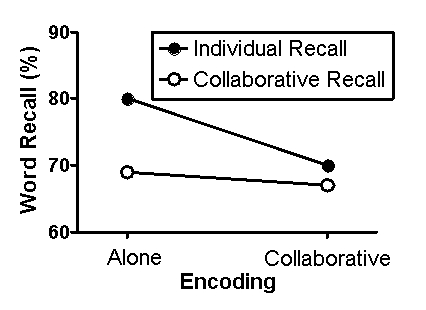Scenario I
Scenario I is based on and provides fabricated data consistent with the following study:
Barber, S. J., Rajaram, S., & Fox, E. B. (2012) . Learning and remembering with others: The key role of retrieval in shaping group recall and collective memory. Social Cognition, 30(1) , 121-132. doi:10.1521/soco.2012.30.1.121
In a typical experiment on collaborative memory, participants first encode information individually and later attempt to recall the information either individually or in a small group (collaboratively) . While the recall of the collaborative group is better than that of any individual, the summed recall of individuals typically is better than the recall of the collaborative group, a phenomenon termed collaborative inhibition. Barber, Rajaram, and Fox (2012) investigated this phenomenon during both the encoding and retrieval stages of memory.
Participants created sentences out of a word bank, which provided for the opportunity to encode this information. After completing this task, participants engaged in an unrelated task-solving mazes-for 10 minutes. Then, in a surprise memory test, they were asked to recall as many words from the word bank as possible (retrieval) .
Participants were randomly assigned to one of four groups. In the first group (Alone-Alone) , participants were studied individually during both the encoding and retrieval phases of the experiment. In the second group (Alone-Collaborative) , participants were studied individually during the encoding phase and studied as part of a three-member team (triad) during the retrieval phase. In the third group (Collaborative-Alone) , participants were studied in a triad during the encoding phase but individually during the retrieval phase. Finally, in the fourth group (Collaborative-Collaborative) , participants completed both phases of the experiment as part of a triad.
Fabricated results illustrating the major finding of Barber et al. (2012) are presented in Figure 6.1. This figure shows the percentage of words from the word bank accurately recalled as a function of group. For the two groups that experienced the retrieval phase individually, scores represent the summed retrieval of the individuals comprising the group. For the two groups that experienced the retrieval phase as part of a triad, scores simply represent the collaborative performance.
Figure 6.1 
-(Scenario I) Which statement is true?
Definitions:
Selling Price
The amount a seller charges for a product or service, determined by costs, market conditions, and competitive pricing.
Contribution Margin
The amount by which the sales price of a product exceeds its variable costs, used to cover fixed costs and generate profit.
Selling Price
The amount of money for which a product or service is sold to customers, determined by costs, market demand, and competition.
Variable Inspection Cost
The cost associated with the examination of products or processes that varies with the level of production or activity.
Q5: Which process most accurately describes the experience-sampling
Q6: In light of research findings on _,
Q6: (Scenario I) If subliminal messages truly are
Q36: A lapse in attention that results in
Q55: Focusing on only the most important details
Q63: Not providing a reinforcer every time a
Q80: Divided attention is associated with an increase
Q92: Robert calls Darla and asks her to
Q170: While cramming for a psychology exam, Hannah
Q233: A memory acquired in one situation is